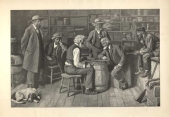The Checker Maven
The World's Most Widely Read Checkers and Draughts Publication
Bob Newell, Editor-in-Chief
Published every Saturday morning in Honolulu, Hawai`i
Noticing missing images? An explanation is here.
Tangled Skeins
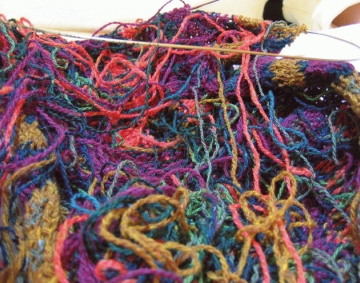
The title for today's Checker School lesson, taken from Ben Boland's Famous Positions in the Game of Checkers, has less to do with the position itself than with the commentary that follows it in the original book. We'll look at the position first, and we'll discuss the commentary in the solutions section of our column.
BLACK
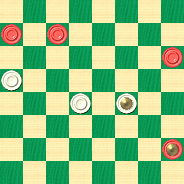
WHITE
White to Play and Draw
W:W13,18,K19:B5,6,12,K28.
White seeks to obtain a man-down draw; as usual, there are compensatory factors that must be relied upon to make up for the material deficit. Here, White's better mobility seems to be his only edge, but whether or not that's enough depends on the skill and technique of the White checkerist.
Can you untangle this one, or will it remain a knotty problem? No worries, you can click on Read More to unwind the solution, explanatory notes, and a sample game, as well as viewing the "Tangled Skeins" commentary.![]()
Russell's Crocodile

We're not at all sure we understand the title of this month's selection from Willie Ryan's Tricks Traps & Shots of the Checkerboard. The entry is labeled "Russell's Crocodile" yet it is all about the Alligator Position! Crocodiles and alligators are most assuredly different creatures; while they are varieties of crocodilians, they respectively belong to the crocodylidae family and the alligatoridae family. Furthermore, according to website wisegeek.com:
"... the crocodile's upper and lower jaws are nearly the same width, so the teeth are exposed all along the jaw line in an interlocking pattern, even when the mouth is closed ... An alligator ... has a wider upper jaw, so when its mouth is closed the teeth in the lower jaw fit into sockets of the upper jaw, hidden from view. Only the teeth of the upper jaw are exposed along the lower jaw line."
We don't know why Willie mixed his metaphor, so to speak; perhaps it is because his expertise ran stronger in checkers than it did in biology. But we can all be grateful for that, as Willie today gives us an entertaining example of the Alligator Position.
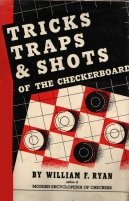
"For sheer brilliance, none of the previously illustrated sparkling gems devised by the great men of draughts shines brighter than the renowned Alligator Position. It was first published as a problem by W. H. Russell at the stage diagrammed below. Later, Southern States Champion F. B. Fishburne, of Columbia, South Carolina, showed how it could arise scientifically in play. Fishburne dubbed it the Alligator Position, 'because it had such a wicked tail-end snap,' and that appropriate appellation has held fast.
| 9-13 | 24-19 | 11-16 |
| 22-17 | 16-23 | 26-23 |
| 13-22 | 26-19 | 16-20 |
| 25-18 | 6-10 | 31-27---3 |
| 11-16 | 25-21 | 2-7---4 |
| 29-25 | 10-17 | 24-19 |
| 5-9 | 21-14 | 7-11---5 |
| 18-14 | 11-16 | 14-10 |
| 9-18 | 28-24 | 11-16 |
| 23-14 | 16-23 | 18-15 |
| 10-17 | 27-18 | 4-8---A. |
| 21-14 | 7-11 | See the |
| 8-11 | 30-26 | diagram. |
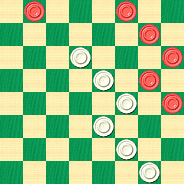
WHITE
White to Play and Win
W:W10,15,19,23,27,32:B1,3,8,12,16,20.
A---Loses, and forms the Alligator Position. 1-5 will produce a draw with careful play---6."
3---This move loses and we're surprised Willie didn't flag it. Correct was 23-19 to a probable draw. After 31-27 2-6 4-8 White cannot avoid the loss of a piece---Ed.
4---But White misses the win with 2-6---Ed.
5---The computer engine KingsRow really doesn't like this move and calls it a probable loss. 1-6 was correct---Ed.
6---However the computer sees this as a dead loss, instead choosing 3-8 in an already hopeless position. See Note 5 above---Ed.
Whatever species you may prefer--- alligator or crocodile--- can you get your teeth around this problem? After you've chewed on it for a while, snap your mouse on Read More to see the solution.![]()
Playing Hardball

Following on the heels of last month's "Two Fisted" checker problem, this month we again play real "hardball" with a position that one of the greats of checker history managed to get wrong. More about that when we discuss the solution, but first let's look at the following diagram.
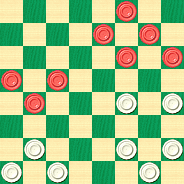
WHITE
White to Play and Win
W:W19,20,25,27,28,29,30,32:B3,7,8,11,12,13,14,17.
The originally published comment on this position was "... the following beautiful position ... appears to be a forced White win." That was something over 85 years ago. Modern computer analysis by KingsRow with the 10-piece endgame database declares the position a likely White win, but with a line of play different from the one published decades back.
In the solution, reached by clicking on Read More, we'll show you the computer line and give you a little more historical background. But first, we invite you to do your own analysis, and at the very least, decide how you would play the position. Certainly, it's a practical exercise, and although indeed we're playing hardball in asking you to do better than one of the game's leading champions of yore, the solution is surprisingly accessible.![]()
Mayday 2010

In previous years, at this point on the calendar, we've explored the various meanings of both the term "Mayday!" and the various festivals that take place on the first day of May. And, although we've looked at the political aspects before, having come across the photo above, we can't help but revisit the topic once again.
The photo is of the enormous and elaborate "First of May Stadium" found in Pyonyang, the capital of the euphemistically-named Democratic People's Republic of Korea (DPRK), better known simply as "North Korea." The photo makes us marvel at the ability of this nation to build huge monuments to Communism and to its own maniacal leadership; to invest heavily in military "defense"; and most of all, to carry out an active nuclear weapons development program--- yet at the same time to be utterly unable to do something as basic as to keep its own people from starving. North Korea is neither "democratic" nor a "people's republic"; it is something both far less and far worse.
As we've so often said, The Checker Maven makes no excuse for standing up in the name of freedom and liberty.
But what has all this to do with checkers? Quite a lot, actually. If you want to think about what is truly "democratic" and what is truly for "the people" then there is little better a model than the game of checkers. It's democratic: anyone can play, and anyone can succeed to whatever degree they wish to work toward that success. It's for the people: checkers is a game that is very easy to learn, incredibly inexpensive, and wholesome, intellectual, and entertaining all at once.
In fact we'd like to suggest the "checkers model" for government, wherein all "men" are created equally, with no special powers or privileges except those earned through the hard work of making his or her way to the crowning row.
All that said, we know you'd like to see your weekly checker problem, and instead of the usual monthly speed problem, we've chosen a problem that is rather easy but still a bit beyond something that should be solved against the clock.
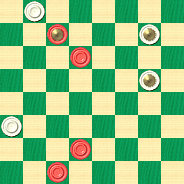
BLACK
Black to Play and Win
B:W12,32,K17,K25:B3,7,23,K27.
Now, this is a democracy, and as one of the "people" you can exercise freedom of choice in selecting your moves. Can you lead the beleaguered force of Black freedom fighters to a win against the army of the White tyrant? Although no one is going to build a huge stadium in your honor if you succeed, we hope you'll try it anyhow, and then click on Read More to see the solution.![]()
Merry - Strickland
There's Merry Hill, and the Merry Hill Shopping Mall, on the Dudley Number One canal, perhaps 10 miles from Birmingham in the U.K. It looks to be a nice setting; we suspect it might tend a bit to the industrial side, but we've not been there to verify.

And there's the Strickland Avenue waterfall, a most assuredly beautiful setting located somewhere in Tasmania. Of course we haven't been there either.
Now, we know for sure that checkers is played in the U.K. and in Tasmania. We know that in the 1880s, checkerists Merry and Strickland published various items of checker analysis (hence today's Checker School lesson). Therefore, a little deductive logic tells us that since Merry published in the American magazine Turf, Field, and Farm he was very likely an American checkerist, and hence Merry Hill is surely not named after him. Checkerist Strickland who published in the Glasgow Weekly Herald, was undoubtedly from the British Isles, making it most unlikely that a street in Tasmania was named after him (although one never knows).
What we can say is that the Merry and Strickland checker settings do indeed possess checkeristic elegance and appeal. Here is the main position.
BLACK
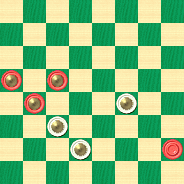
WHITE
White to Play, Black Wins
W:WK14,K11,K7:BK20,K19,K16,5.
Black is a piece up and of course that is supposed to mean an eventual, if not a straightforward win. But given White's centralized king positions, Black is going to have to work hard and patiently to achieve victory. The winning procedure in fact requires a high level of technique and is very much worth mastering.
So, sail down the canal but don't go over the falls; instead, make Merry and find the solution. Then click on Read More to see detailed notes and explanations as well as a sample game.![]()
The Big Squeeze
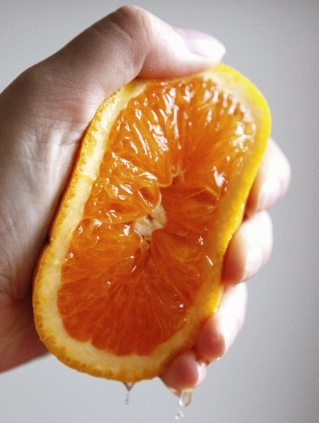
There's nothing so good as fresh-squeezed juice as a morning pick-me-up; it just can't compare with cardboard cartons, concentrates, or powders. However, we do recommend a somewhat different squeezing method than that shown in the photo above; at the very least, you might wish to squeeze your juice into a cup or glass instead of onto your hands or onto the table.
There are squeezes in checkers, too, and although they don't directly produce juice, they just might produce a nice victory. Willie Ryan, in his classic work Tricks Traps & Shots of the Checkerboard, has a page or two on squeeze plays, and he's here in print to explain to us just how it works.

"One of the most unusual games I ever won was the strange coup I sprung on the renowned John T. Bradford of Philadelphia, a member of the American International Checker Team of 1927, in the American Championship Tourney of 1937; and I believe it is the only win of its kind on the published record. The game leading up to this peculiar situation is reproduced on the next page, exactly as we played it.
| 10-14 | 9-14---A | 15-24 |
| 23-18 | 18-11 | 28-19 |
| 14-23 | 7-16 | 2-7 |
| 27-18 | 26-23 | 31-26 |
| 12-16 | 4-8 | 1-6 |
| 32-27 | 22-17 | 22-18 |
| 16-20 | 8-12 | 14-17 |
| 26-23 | 25-22 | 21-14 |
| 6-10 | 3-7 | 10-17 |
| 30-26 | 24-19 | 25-21 |
| 11-15 | 7-11 | 6-10 |
| 18-11 | 17-13 | 21-14 |
| 8-15 | 11-15 | 10-17 |
| 23-18 | 29-25 | 19-15---B |
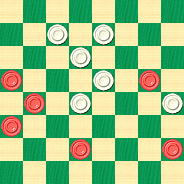
BLACK
Black to Play and Win
B:W27,26,23,18,15,13:B20,17,16,12,7,5.
A---First introduced by me at the 1937 American Championship Tourney, departing from the usual line by 7-11.
B---The wrong one. A draw is gained easily with: 18-14*, 7-11, 13-9, 17-21, 9-6, 21-25, 6-2, 25-30, 2-7, 11-15, 19-10, 16-19. After 19-15, black starts the biggest squeeze play on record, going all the way from square 7 to square 22 before regaining the sacrificed piece."
Willie certainly gives a giant hint in his second note, but we still believe you'll have to give this one a little thought to squeeze out the solution. Find the Black win and then squeeze the mouse button over Read More to see the answer.![]()
Two-Fisted Checkers

No fooling around, no sir-ee. What we have here today is an honest-to-goodness two-fisted, hard-core, serious checker problem. This week, wimpy checkerists need not apply. Do you think you're good? Do you have what it takes? Prove it. Have a look at this one. Read 'em and weep.
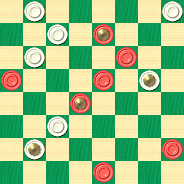
BLACK
Black to Play and Win
B:W32,29,27,24,K17,11,K8:BK26,22,20,18,K15,5,2.
This problem was first published, as far as we know, something over 85 years ago, and it was variously listed as "advanced," "extra diffcult," and other such things. They weren't a-kiddin', folks. If you can solve it, you're good.
If you can't, there's always the Read More link, which will solve it for you. But you don't want that, do you? Stay in the fight and solve it on your own!![]()
Relocation Complete!

Our containers have been offloaded and unpacked, and the relocation of our main Checker Maven office from Santa Fe to Honolulu is at least relatively complete; there's always more to do and we wonder if anything like this is ever really quite finished. It took a little longer than expected, which again is not a big surprise, but we're happy to be here and to have a long and complex move behind us.
As we've said before, our parent company, Mr. Fred Investments, couldn't continue to maintain two locations for a subsidiary that was never intended to make a profit (and surely doesn't!). This has been our second downsizing, but it's been, we hope, without sacrificing content or quality. And now, with the economy beginning to come back at least somewhat, we look forward to a bright future. Thanks for staying with us.![]()
April Showers

It's said that April showers "bring May flowers." Certainly, that's true at least in certain parts of North America, where, after a long winter season, the arrival of spring as a harbinger of warmer days is much awaited and indeed can't seem to come quickly enough.
And speaking of "quickly" it's our first column of the month, which brings neither showers nor flowers, but a speed problem. This one requires a little more thought than some others, and so we'll set the clock to 60 seconds. Can you solve our one-minute mystery? Click on the link below to set the second hand in motion and reveal the problem. Then, come back and click on Read More to have the solution rain down upon you.
April Speed Problem (medium difficulty)
![]()
Great Men Like Checkers

There's no doubt that many a great man was a checkerist, and you'll see why we've chosen the title Great Men Like Checkers for today's Checker School column when you read through the solution section.
The definition of a great man can vary. Some think of great national leaders, others think of religious figures, and still others might vote for sports heroes. There is room for all of these, and more. Our photo above shows a great baseball player from the olden days, Christy Mathewson, who besides being a baseball Hall of Famer, was also a master checker player.
On the other hand, few people remember checkerist Fred Allen; and thought he might not be a member of the Hall of Fame, he is credited with a very fine and instructive checker position, which forms the subject of our column today. In our opinion, it's more than enough to secure Mr. Allen's place in checker history.
WHITE
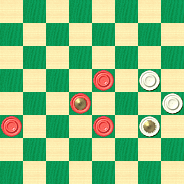
BLACK
Black to Play and Win
B:W17,13,K9:B18,K15,12,10.
It's an intriguing layout: the near-symmetry of the three per side on the right offset by the lone extra Black man on square 12. Is it enough for a Black win? According to Mr. Allen, it is indeed, but it's all in knowing how. Can you demonstrate your own checker greatness by showing how it's done? Solving the problem likely won't make you into a Hall of Famer, but work it through and then click on Read More to see the solution, no less than five sample games (this is indeed a practical exercise), and explanatory notes.![]()
The Checker Maven is produced at editorial offices in Honolulu, Hawai`i, as a completely non-commercial public service from which no profit is obtained or sought. Original material is Copyright © 2004-2025 Avi Gobbler Publishing. Other material is public domain, as attributed, or licensed under Creative Commons. Information presented on this site is offered as-is, at no cost, and bears no express or implied warranty as to accuracy or usability. You agree that you use such information entirely at your own risk. No liabilities of any kind under any legal theory whatsoever are accepted. The Checker Maven is dedicated to the memory of Mr. Bob Newell, Sr.


